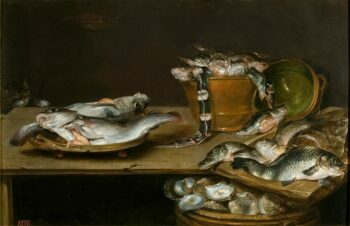If you make homemade cat food for your furry friend, you know that your cat needs a “balanced diet.” This diet will contain all the necessary nutrients required to ensure health and activity.
If you have not already done so, read the previous post on this website called “Do You Know The Nutritional Needs Of Your Cat” to learn more specific information on what kitty needs in his diet.
Homemade recipes may vary, as to which supplements they call for. Some recipes may not include all the vitamins or supplements that another recipe calls for, and the reason might have to do with the meat in the recipe. The meat itself may provide the missing vitamins.
Important to use a variety of meats
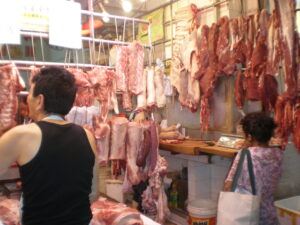 Some meats might have small deficiencies in vitamins B and E, and may be slightly low in minerals. If you use a variety of different meats in your homemade food, the insufficiencies could be met.
Some meats might have small deficiencies in vitamins B and E, and may be slightly low in minerals. If you use a variety of different meats in your homemade food, the insufficiencies could be met.
Be sure to choose the right supplements. If you use a prepared multivitamin premix, use only the ones meant for homemade pet diets. Do not use generic pet supplies or multivitamins designed for human consumption.
Don’t go overboard with supplements
More doesn’t always equate to better. It would be safer to have your homemade food slightly under-supplemented than over-supplemented. With fat-soluble vitamins such as A and D, avoid adding these at all in concentrated forms.
Dr. Susan Schaff, our Gustavus veterinarian, recommended a website that you may find helpful. It’s called balanceit.com. On this website, you choose the meat and other ingredients you plan to use, and the website will tell you what supplements you need.
Essential Nutrients
Consider protein and water as the two most essential nutrients that your cat food has to contain. The cat must have the protein to grow, develop, thrive, and even to survive. The water in the food ensures that the cat receives proper hydration, influencing his skin, coat, and his well-being.
Many of the needed amino acids come from meat. Of course, vitamins and minerals, also essential, must receive a proper place.
Follow these simple rules:
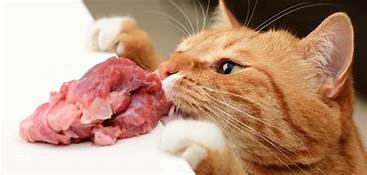
- Since cats are obligate carnivores, they need a high-protein, meat-based diet. Feeding them a low-protein high-carbohydrate diet will not do. There is no such thing as a vegan cat.
- If you need additional supplementation, here are essential needs: Always add liver and taurine. You can purchase taurine from Amazon, if you have no other choice. Add calcium to boneless meat. Though boneless meat alone can provide almost all of the nutrients your cat needs, it has almost no calcium.
What are the benefits of making your own food?
You can find some good reasons for feeding your cats meals you make yourself. These include:
- You can control the ingredients as well as the cooking process.
- You can protect your kitty from a variety of allergic reactions.
- Your homemade food can help improve kitty’s skin and coat.
- Raw food provides about 80% moisture as compared to commercial cat food, which offers just 10%.
- Your homemade food can improve the cat’s digestion and makes for healthier litter box habits.
- By making your own cat food, you can give the cat more energy.
- You can save money by cooking cat food at home.
RECIPES
Turkey Delight for Cats
INGREDIENTS
1 1/2 cups water
1/2 tsp iodized salt (optional)
2 teaspoons corn oil
1/2 cup brown rice, uncooked
1/2 pound raw turkey giblets, chopped into kitty-size pieces
1/4 cup carrot, chopped fine
1/2 cup chopped spinach
INSTRUCTIONS
Combine salt, oil, and water and bring to a boil. Pour rice in boiling water, lower heat, cover and cook for 10 minutes. Stir in turkey giblets, carrot, and spinach. Cover and cook on low heat for another 10 or 15 minutes.
Salmon Cat Food Recipe
INGREDIENTS
2 cups cooked salmon 2 tbsp steamed broccoli
2 tbsp fish oil
2 boiled eggs
EQUIPMENT
Blender or food processor
Storage container
INSTRUCTIONS
Combine all of the ingredients in a bowl or food processor. Blend until the mixture is even. Divide your homemade cat food into individual portions. Store leftovers in the refrigerator or freezer
2 tbsp steamed broccoli
2 tbsp fish oil
2 boiled eggs
EQUIPMENT
Blender or food processor
Storage container
INSTRUCTIONS
Combine all of the ingredients in a bowl or food processor. Blend until the mixture is even. Divide your homemade cat food into individual portions. Store leftovers in the refrigerator or freezer
Simply Chicken
INGREDIENTS
1 cup cooked chicken
1/2 cup mashed steamed broccoli
Chicken broth (or water) as needed
INSTRUCTIONS
Mix the ingredients in a food processor, gradually adding broth (or water) until a smooth mixture is formed. Now it's ready to serve.
Recipe for Salmon Biscuit
INGREDIENTS
1 cup oat flakes
1/4 cup canned salmon
1/4 cup flour
1 egg
2 tsp olive oil
INSTRUCTIONS
Preheat oven to 380 degrees Fahrenheit. Mix all ingredients until you obtain a thick, smootn consistency. Shape dough into small balls, then flatten them. Place the biscuits on a parchment paper covered tray, then cook in the oven for 10 minutes or until thoroughly baked. Let them cool; give cat a sample; place in fridge and use for treats.
Almost-Spot’s Stew
INGREDIENTS
1 whole chicken (preferably free range or packaged with "no hormones or antibiotics" on the label.)
2 cups brown rice 6 stalks celery
8 carrots (scrubbed but not peeled)
2 or 3 yellow squash
2 or 3 zucchini
1 small broccoli crown
handful of green beans
INSTRUCTIONS
Wash chicken, then cover with water in a large stew pot.
Cut vegetables into pieces and add to pot.
Add rice
Cook until chicken almost falls of the bone and vegetables are tender.
Completely debone the chicken. This is extremely important as cooked chicken bones can splinter and cause serious intestinal damage.
Pour the stew into a blender and blend or chop until mixture is coarse (about bite-sized).
Freeze in meal-sized plastic bags.
6 stalks celery
8 carrots (scrubbed but not peeled)
2 or 3 yellow squash
2 or 3 zucchini
1 small broccoli crown
handful of green beans
INSTRUCTIONS
Wash chicken, then cover with water in a large stew pot.
Cut vegetables into pieces and add to pot.
Add rice
Cook until chicken almost falls of the bone and vegetables are tender.
Completely debone the chicken. This is extremely important as cooked chicken bones can splinter and cause serious intestinal damage.
Pour the stew into a blender and blend or chop until mixture is coarse (about bite-sized).
Freeze in meal-sized plastic bags.
Rabbit Stew
INGREDIENTS
1/2 lb. rabbit meat sliced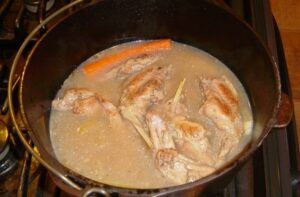 1 teaspoon olive oil
Vegetable stock, unsalted
20 g sweet potato
20 g carrot
20 g celery
dash of parsley, rosemary, thyme, marjoram
1 teaspoon olive oil
Vegetable stock, unsalted
20 g sweet potato
20 g carrot
20 g celery
dash of parsley, rosemary, thyme, marjoram
INSTRUCTIONS
Saute rabbit slices in olive oil, sprinkle with chopped parsley, rosemary, marjoram and thyme. Cover with vegetable stock, put the dish into the oven and let it boil. Then turn down to a simmer. Add chopped vegetables and return to the oven for 45 minutes. Let the meal cool and serve.
(This recipe comes from petcubes.com. See listing in references.)
RECIPES USING RAW MEAT
RAW FOOD RECIPE FOR HEALTHY CATS
INGREDIENTS
2 kg chicken thighs with bones (other meats can be used in this recipe)
200g raw chicken liver
400g raw chicken heart
1 cup water
4 raw egg yolks
2000mg taurine
Recommended supplements to add
4000mg fish oil or feed canned sardines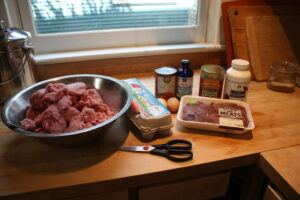 200mg vitamin B
200mg vitamin E
50mg manganese supplement
200mg vitamin B
200mg vitamin E
50mg manganese supplement
Putting Together The Raw Cat Food
At room temperature and following the original chicken recipe with no meat variations, first, remove the skin from half of the chicken thighs. If your cat is overweight, remove all of the skin and fats.
Next, remove the bone from 20 to 25% of the thighs. Weigh out the amount of raw food you need to feed your cat according to your cat’s weight or according to the recipe and rinse the meat thoroughly. The current recipe is for more than one meal so you can portion what you need and keep the leftovers in the freezer.
Add any supplements necessary according to your individual cat needs.
Add in the yolks and water to the mixing bowl and mix until well combined.
Weigh out the liver and heart and cut up the meat into cubes. Then start feeding the chicken thighs through the grinders. At intervals, add in the liver and heart to the grinder.
Once it is done and you have your ground meat, add in the yolks, water and supplements and mix it all thoroughly.
Portion the food, feed your cat, and don’t forget to wash all equipment. All extra portions should be frozen immediately so it does not get contaminated.
ORIGINAL RAW CAT FOOD RECIPE
(This recipe is from tcfeline.com. You can find the link at the end of this post under references used.)
INGREDIENTS
700g (1 1/2 pounds) raw, ground, lean muscle meat WITHOUT bone.
200g (1 cup) raw, ground heart
100g (1/2 cup) raw, ground or pureed liver
236ml (1 cup) water
2 raw egg yolks
2 tbsp edible bone meal
1 tbsp gelatin
4000mg salmon oil
2000mg taurine
400 IU vitamin E
Yields -- 10 days of food or 20 x 1/4 cup portions
You do not need to add Vitamin A, B, or D, because these occur naturally in both the raw egg yolk and raw liver.
Do not add whole egg, but only the egg yolk. Egg white contains the enzyme Avidin which will make the essential B vitamin Biotin unavailable to your cat.
Add 1 can salmon, sardines, or mackerel packed in water as a source of Omega 3 fatty acids instead of 4000mg salmon oil, or an Omega 3 fish oil, if you wish.
HOW TO PREPARE
Separate the yolks from the egg white and drop yolks into mixing bowl. Grind or puree the liver. (Make sure no chunks included) Add the water, cold. Give egg yolk, liver, and water a mix with a whisk Measure your dry ingredients precisely. Pull apart Taurine capsules to total 2000mg. The bottle will tell you how much Taurine is in each capsule. Cut into or poke each salmon oil capsule and squeeze contents into the bowl. Give the mixture another whisk until smooth. Add heart meat and combine with previous ingredients until evenly mixed. Finally, add your muscle meat. Chunks must be ground small so the cat eats the complete mixture. Without too much vigor, evenly stir the muscle meat into the ingredient blend
Boneless meat needs added calcium
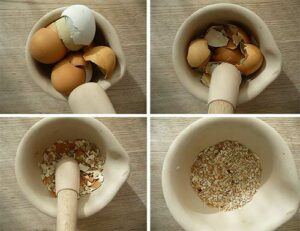
You need to add about 1000 to 1200mg of calcium per pound of meat. It is recommended to use eggshell powder. Eggshells are about 90 to 97% calcium carbonate. Calcium carbonate is 35 to 40% elemental calcium. You will need to get an accurate measurement of what your eggshell powder weighs per teaspoon to be able to add the right amount. Aim to add approximately three grams per pound of meat. A scale that accurately weighs small amounts is helpful. Use it to add 3 grams per pound. If you purchase eggshell calcium, make sure it is pure eggshells with nothing else added. Follow the directions on
the product for how much to add per pound of meat. To make your own eggshell powder: Remove any egg white from the shells but leave the membrane as it contains
valuable nutrients. Dry them by baking at 300 degrees F for 10 minutes. Grind them in a clean coffee grinder or
food processor. Wait 10 minutes before opening to let the powder settle. One large egg will make about one
teaspoon of powder. Store the powder in an air-tight glass jar. Armed with this information, you can now try it out. If you need other recipes, look at the references below or go online to find more. May you and your cat enjoy this new creation process. References I used for this post: feline-nutrition.org/nutrition/making-raw-cat-food-for-do-it-yourselfers tcfeline.com/original-raw-cat-food-recipe/ http://petcubes.com/blogs/raw-cat-food/raw-cat-food-recipe excitedcats.com/wprm_print/34430/ catspeople.com/blogs/cat-names/homemade-cat-food-recipes ovrs.com/blog/homemade-cat-food/ http://thesprucepets.com/homemade-cat-food-recipes-551946 catspurfection.com/homemade-cat-food/ pawsomecats.com/balanced-raw-cat-food-recipe-supplements/ feline-nutrition.org/nutrition/homemade-cat-food-a-balancing-act

